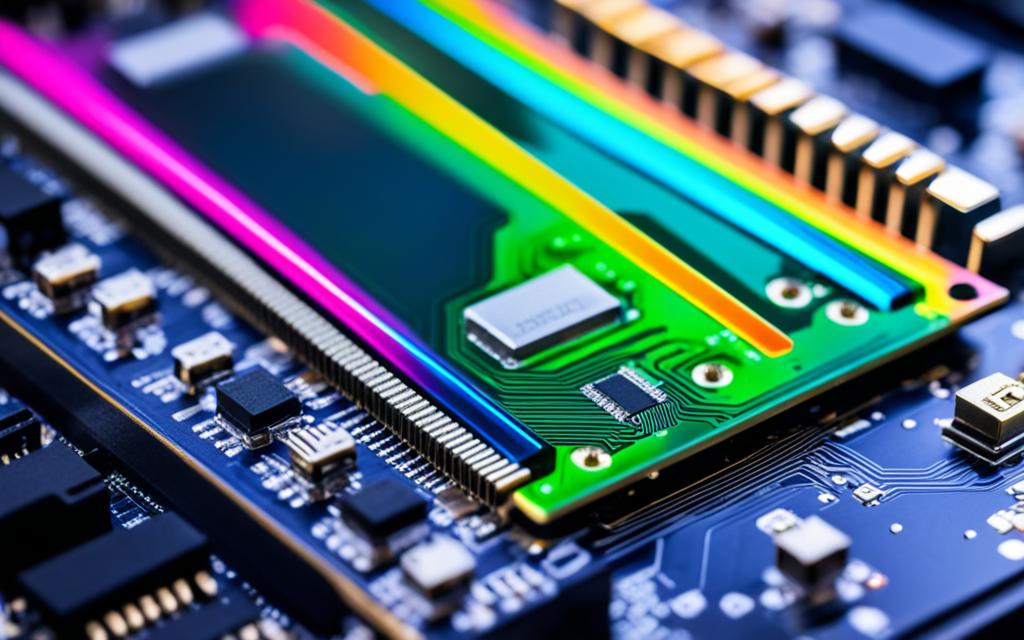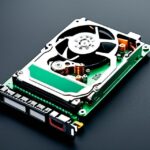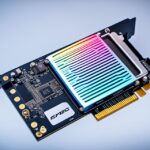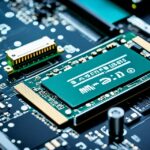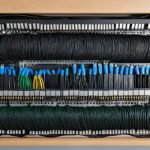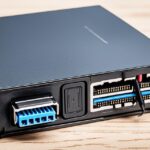Table of Contents
Adding Solid-State Drives (SSDs) to your system can greatly boost performance. But you need to understand how SSDs match up with different motherboards. As SSDs are now top choices for storage, their varying types can cause some confusion. This is especially true when you’re looking at motherboard connections. Not all SSDs, like SATA or the newer PCIe types, will fit easily with every motherboard.
We’ll help you navigate through the SSD types and their connections. Choosing the right SSD makes your computing smoother and more efficient. Knowing your motherboard’s compatibility before buying new hardware is key. For more detailed information on compatible M.2 SSDs, click here.
Key Takeaways
- Understanding the differences between SATA and PCIe SSDs is vital for effective upgrades.
- Not all motherboards support all SSD types; factors like interface and physical size matter.
- M.2 connectors come in various specifications, affecting compatibility with different motherboards.
- Check the motherboard specifications to ensure optimal performance with an M.2 SSD.
- Compatibility can be influenced by the version of the operating system being used.
Understanding SSD Types and Interfaces
The storage world keeps changing, making it crucial to understand different SSD types and interfaces. Each interface has its strengths and weaknesses, affecting your choice depending on your computer’s needs.
What are SATA, PCIe, M.2, and NVMe?
SATA interface is well-known in SSD storage, starting in 2003, especially for desktops. It’s a bit slow, with speeds up to 6Gb/s, which can be limiting. On the other hand, PCIe interface leaves SATA in the dust. With NVMe SSDs, speeds can shoot up to 7,000MB/s in M.2 forms, boosting high-demand tasks like video editing12.
NVMe technology took off between 2005 and 2010, outpacing hard drives in speed3. It uses the PCIe bus with less CPU strain, enhancing performance further2. The M.2 form factor is versatile, fitting more than just SSDs, and supporting a broad range of parts.
Differences in Speed and Performance
Speed comparisons show a huge gap between SATA and PCIe NVMe. SATA is cheaper and common, but its speed tops out around 500 Mbps2. PCIe NVMe zooms past it, being three to ten times quicker than SATA SSDs. This makes it a go-to for those needing fast data access.
Knowing about SSD types and interfaces helps you choose wisely for your setting. This can greatly impact how long and well your system runs, especially if you do tasks that need a lot of power.
Looking to boost your PC’s power? Check out this guide for useful tips and deeper dives132.
Compatibility: Are all SSD compatible with all motherboards?
It’s important to know how SSDs and motherboards work together for the best performance. Motherboard factors are key in determining if an SSD will work right. Compatibility depends on the supported interface, SSD size, and slot types.
Factors Affecting Compatibility
Compatibility issues often stem from the difference in SSD technology and size. Interfaces like SATA and PCIe vary greatly, with SATA at 6GB/s and PCIe Gen 5 at up to 14,000MB/s. This shows a big jump in speed. Also, not all motherboards fit the longer M.2 SSDs, so checking size and interface match is crucial4.
- Check computer manuals or model specifications.
- Identify the model of the currently installed drive.
- Disassemble the PC to view the port and hard drive bay.
To figure out if an SSD fits, these steps can really help. A common mix-up is thinking SATA and PCIe SSDs are interchangeable without any issues. This is not always the case.
Common Misconceptions
There are plenty of myths about SSDs, like thinking you can swap SATA for PCIe easily. Not all pcs can switch SSD types without problems4. If you try to fit a SATA SSD in a PCIe slot without dual-mode, it might not work at all.
| Interface | Speed | Common Sizes | Keying |
|---|---|---|---|
| SATA | 6GB/s (600MB/s) | 2.5″, 3.5″ | N/A |
| PCIe Gen 5 | Up to 14,000MB/s | 2242, 2260, 2280, 22110 | M key |
| PCIe M.2 | Faster NVMe SSD support | 2242, 2260, 2280 | B & M key |
Understanding motherboard factors and SSD myths is key to making the right choice. This knowledge helps users pick the best SSD for their system5.
M.2 Connector Shapes and Their Importance
M.2 connector types are vital for SSDs working with different devices. They support different keys, like the B key and M key. It’s important to know these to choose the right SSD.
Identifying B & M Key Specifications
The B key and M key connectors show what SSD type fits in an M.2 slot. B key slots fit SATA M.2 SSDs, and M key slots are for PCIe M.2 SSDs. Knowing this makes it easier to match SSDs with systems and avoid mistakes. There are 12 key IDs, including B, M, and B+M. They show how to connect modules to the motherboard6.
Understanding the Impact of M.2 Size
SSD sizes in the M.2 form come in different dimensions. For instance, 2242, 2260, and 2280 measurements are common. These numbers represent the width and length in millimetres. The right size must fit the motherboard’s room.
Different SSDs offer varying data transfer rates. NVMe drives deliver faster speeds than SATA III SSDs. This means quicker data access for users7.
| Key Type | Connector Type | Speed | Typical Use |
|---|---|---|---|
| B key | SATA M.2 SSD | 6 Gb/s | Older systems and budget builds |
| M key | PCIe M.2 SSD | 15.75 Gb/s (x2), 31.5 Gb/s (x4) | High-performance applications |
| B+M key | Dual-mode SSD | Variable, depending on use | Versatile installations |
In summary, knowing about M.2 connector types and the B key and M key options is key. Along with understanding SSD sizes, it ensures systems perform their best6.
Verification of Motherboard Compatibility
Checking if a new SSD will fit your system is key. First, identify your motherboard model. Use tools like Dxdiag to get system info easily. After finding the model, go to the manufacturer’s site. There, look for details on SSD types that work, like SATA or PCIe45. Also, check the maximum length for M.2 SSDs that fit.
How to Check Your Motherboard Specifications
Motherboard specs help you choose the right SSD. They show if NVMe SSDs for faster performance are supported or just SATA connections. Checking the M.2 slot specs tells you the needed SSD length and type for a good fit4. Some SSD brands offer tools to make these checks easy5.
Finding the Right SSD for Your Setup
With a compatible match confirmed, picking the right SSD is next. Decide if you want speed with PCIe NVMe drives or affordability with SATA. Longer M.2 SSDs have more storage but cost more. Following these fitting tips ensures your new SSD works well with your motherboard. This boosts your system’s overall speed4.
FAQ
What is SSD compatibility and why is it important?
SSD compatibility means a solid-state drive works well with various motherboards. It’s vital because it ensures top performance and smooth upgrades. This avoids problems like slower speeds or the SSD not working at all.
What are the different types of SSDs available?
There are several SSD types. SATA SSDs connect via the SATA interface. PCIe SSDs use newer tech for faster speeds. M.2 and NVMe SSDs also exist, offering different performance levels for various needs.
What are the main differences in speed and performance between SSD types?
SATA SSDs provide speeds up to 6GB/s. PCIe SSDs can go as high as 14,000MB/s, especially with Gen 5. NVMe tech makes PCIe SSDs much quicker than SATA ones, boosting data transfer effectively.
Are all SSDs compatible with all motherboards?
Not all SSDs fit all motherboards. Compatibility depends on the SSD’s interface, size, and the motherboard’s M.2 slot configuration. These factors must align for a proper fit.
What factors affect SSD compatibility with a motherboard?
Several things influence compatibility. These include the SSD’s interface, its size, and how the M.2 slots are keyed. Matching these details with your motherboard prevents compatibility issues.
What common misconceptions exist about SSD interchangeability?
Many think any SSD can fit any slot. However, SATA SSDs cannot go into PCIe slots without special support. This mistake underlines the importance of researching before buying.
How do I identify the key specifications of M.2 connectors?
M.2 connectors are marked with B and M keys, indicating compatibility. B-key slots work for SATA M.2 SSDs. M-key slots fit PCIe M.2 SSDs and SATA, if they support dual-mode.
How does the size of M.2 SSDs affect compatibility?
M.2 SSDs come in different lengths. Matching the SSD’s size with your motherboard’s slot is crucial. This is particularly important in compact setups.
How can I verify if my motherboard is compatible with a specific SSD?
Check your motherboard model via tools like Dxdiag. Visit the manufacturer’s site for SSD type and size support. This helps in picking the right SSD.
What steps should I take to find the right SSD for my setup?
Start by understanding your motherboard’s specs. Assess your storage requirements. Choose an SSD that fits your performance needs and is compatible. This ensures it works well with your setup.
Source Links
- https://www.kingston.com/en/blog/pc-performance/ssd-form-factors – Types of SSD Form Factors- Kingston Technology
- https://www.axiomupgrades.com/spotlight-detail/Understanding-SSD-specifications/ – Axiom | The OEM Alternative
- https://www.10gtek.com/new-1415 – An Introduction to SSD Interface
- https://www.xda-developers.com/m2-ssd-compatible-with-motherboard/ – How to know if an M.2 SSD is compatible with your motherboard
- https://www.partitionwizard.com/clone-disk/ssd-compatibility.html – SSD Compatibility Check: How to Buy a Compatible SSD for PC – MiniTool Partition Wizard
- https://www.atpinc.com/blog/what-is-m.2-M-B-BM-key-socket-3 – What is M.2? Keys and Sockets Explained
- https://www.kingston.com/en/blog/pc-performance/two-types-m2-vs-ssd – 2 Types of M.2 SSDs: SATA and NVMe- Kingston Technology

